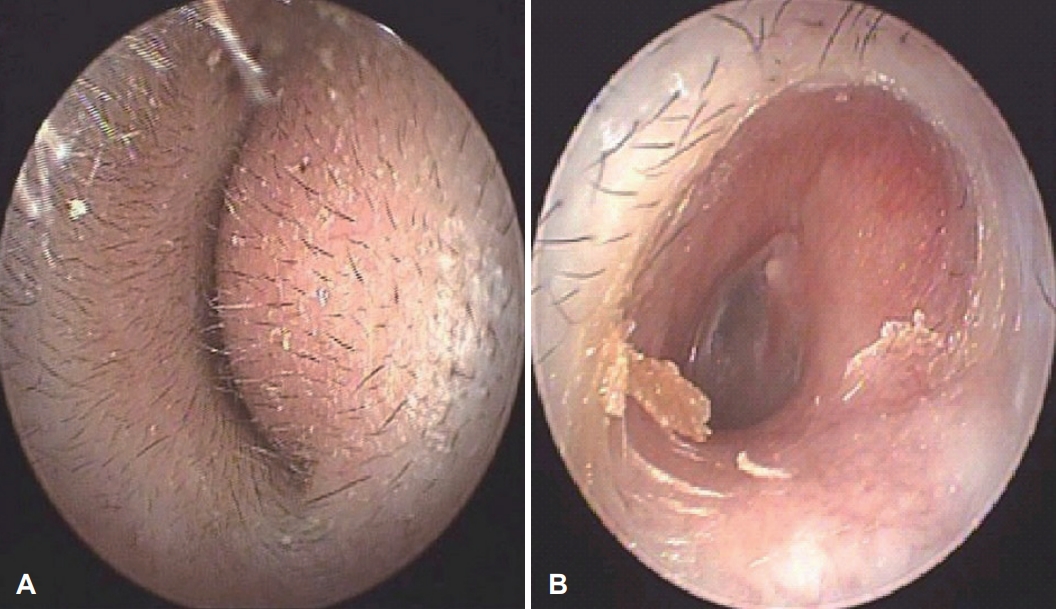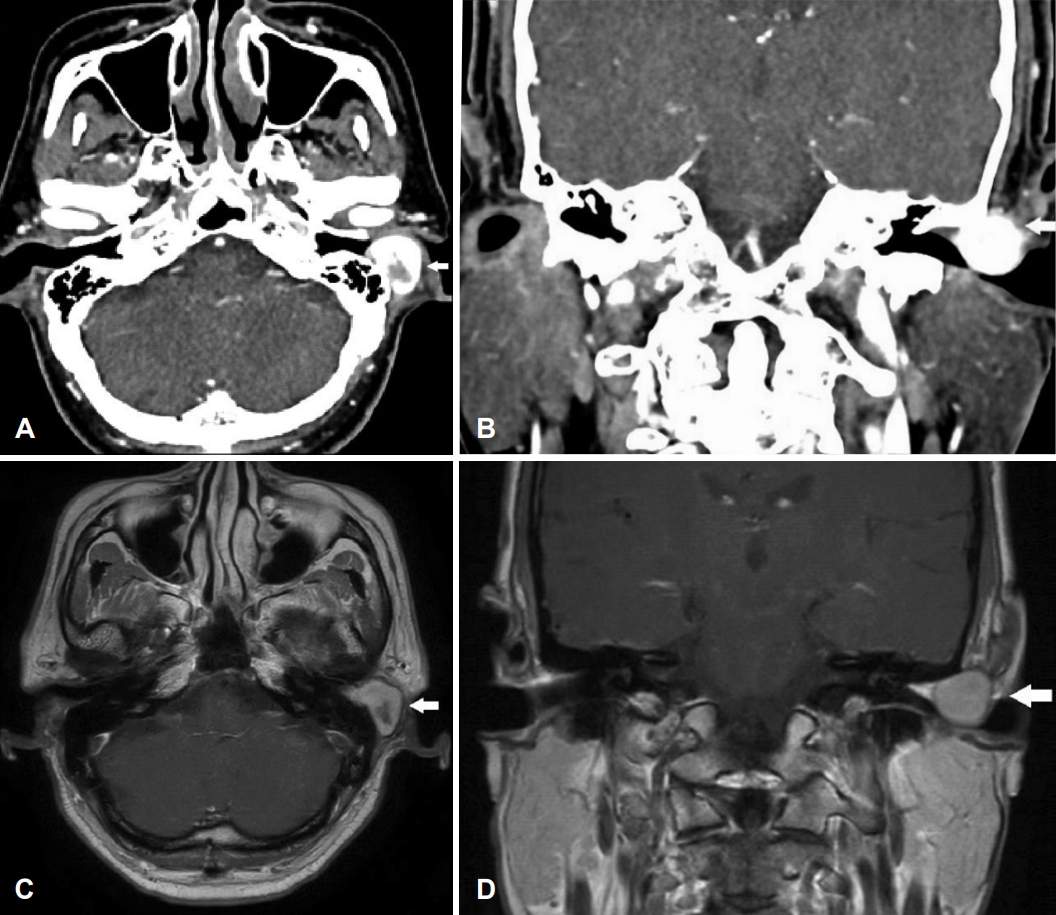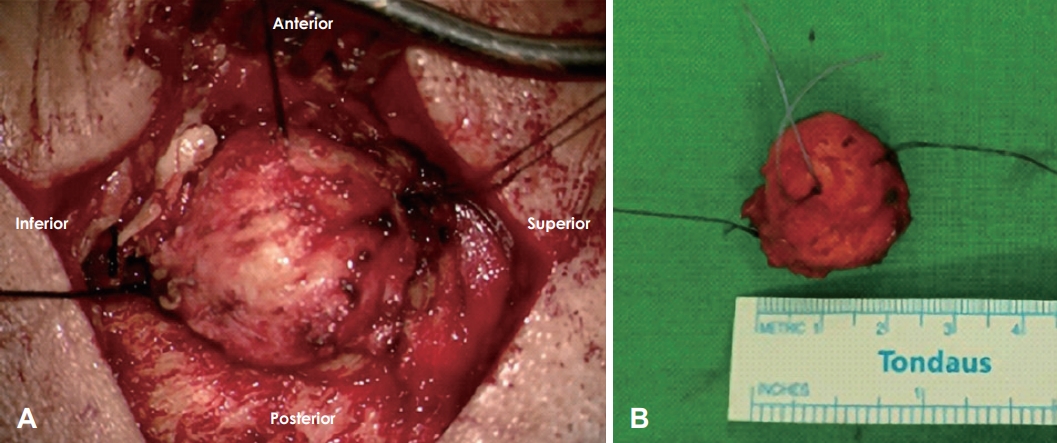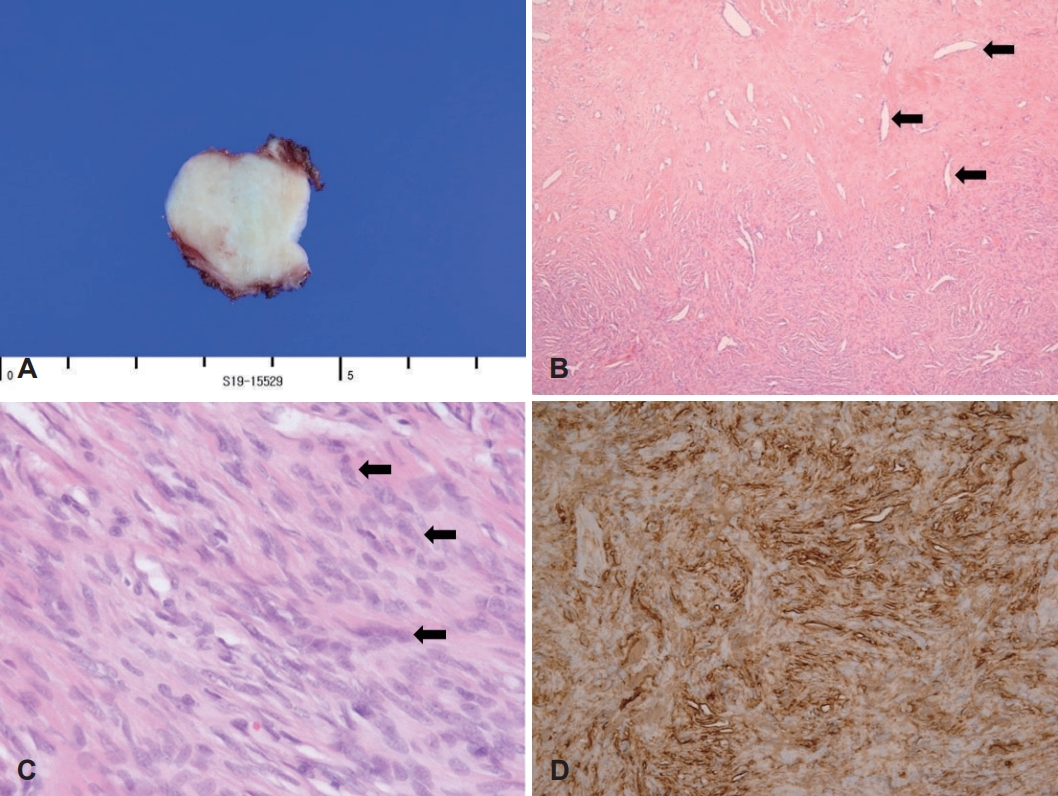 |
 |
AbstractSolitary fibrous tumor (SFT) is a rare benign spindle-cell neoplasm, most often found in the pleura. Recently, it has been reported to appear throughout the body but rarely in head and neck region. Tumors in the external auditory canal, in particular, have been very rarely reported. We experienced a case of a 55-year-old male with a 6-month history of progressive swelling from the orifice of left external auditory canal. The tumor was round, well circumscribed, almost completely obstructing the left external auditory canal. On the enhanced temporal bone CT and enhanced paranasal sinus MRI, a 2.0√ó1.7 cm sized mass was observed at the left external auditory canal. He was treated with surgical excision under general anesthesia. Histopathologic examination confirmed the diagnosis of SFT. This case report presents a rare case of a SFT arising in the external auditory canal.
žĄú Ž°†Í≥†Ž¶ĹžĄĪ žĄ¨žú†žĘÖ(solitary fibrous tumor, SFT)žĚÄ ž£ľŽ°ú ŪĚČŽßČžĚė ÍįĄžóĹžĄłŪŹ¨žóźžĄú ÍłįžõźŪēėŽäĒ ŽďúŽ¨ł žĖĎžĄĪ Žį©ž∂ĒžĄłŪŹ¨ žĘÖžĖĎžúľŽ°ú(mesenchymal tumor) 1931ŽÖĄ KlempereržôÄ Rabin [1]žĚī ž≤ėžĚĆžúľŽ°ú Ž≥īÍ≥†ŪēėžėÄŽč§.
ŪĚČŽßČ žôłžóźŽŹĄ Ž≥ĶÍįē, žĘÖÍ≤©ŽŹô, ŪŹź, ÍįĄ, žč†žě• ŽďĪ žč†ž≤ī ž†ĄŽįėžóźžĄú ŽįúžÉĚŪē† žąė žěąžúľŽ©į[2], ŽĎźÍ≤ĹŽ∂Ä žėĀžó≠žóźžĄúŽäĒ ÍĶ¨Íįē, ŽĻĄÍįē, Žąą, ŪõĄŽĎź, ÍįĎžÉĀžĄ†, žĻ®žÉė, Ž∂Ğ̳ŽĎźÍįē ŽďĪžóźžĄú ŽįúžÉĚŪēúŽč§[3]. žĚīž§Ď žôłžĚīŽŹĄžóźžĄú ŽįúžÉĚŪēėŽäĒ Í≤ĹžöįŽäĒ ÍĶ≠žôł 4žėą, ÍĶ≠Žāī 1žėąŽ°ú Žß§žöį ŽďúŽ¨ľÍ≤Ć Ž≥īÍ≥†ŽźėžóąŽč§(Table 1).
Í≥†Ž¶ĹžĄĪ žĄ¨žú†žĘÖžĚÄ ž°įžßĀŪēôž†Ā Í≤Äžā¨Ž•ľ ŪÜĶŪēī žßĄŽč®ŪēėŽ©į, žĚīžóź ÍįźŽ≥ĄŪēīžēľ Ūē† žßąŪôėžúľŽ°úŽäĒ žč†Í≤ĹžĄ¨žú†žĘÖ, žč†Í≤ĹžīąžĘÖ, žĄ¨žú†žú°žĘÖ, ŪėąÍīÄž£ľžúĄžĄłŪŹ¨žĘÖ ŽďĪžĚī žěąŽč§[4]. ŪėĄžě¨ÍĻĆžßÄ žôłžĚīŽŹĄžóźžĄú ŽįúžÉĚŪēú Í≥†Ž¶ĹžĄĪ žĄ¨žú†žĘÖžĚÄ Žß§žöį ŽďúŽ¨ľžĖī Í∑ł ŪäĻžĄĪžĚĄ ŽÖľžĚėŪēėÍłī žĖīŽ†§žöįŽāė, ŪĚČŽßČ žôł Í≥†Ž¶ĹžĄĪ žĄ¨žú†žĘÖžĚė ŪäĻžĄĪžĚĄ Í≥†Ž†§ŪēīŽ≥łŽč§Ž©ī žēÖžĄĪ ŽįŹ žě¨Žįú ÍįÄŽä•žĄĪžĚī žěąžúľŽĮÄŽ°ú[5], ÍįÄŽä•ŪēėŽ©ī žąėžą†ž†ĀžúľŽ°ú žôĄž†ĄŪěą ž†ąž†úŽźėžĖīžēľ ŪēúŽč§[4].
Ž≥ł ž†ÄžěźŽď§žĚÄ 55žĄł Žā®ŪôėžĚė žôłžĚīŽŹĄžóź ŽįúžÉĚŪēú Í≥†Ž¶ĹžĄĪ žĄ¨žú†žĘÖ 1žėąŽ•ľ Í≤ĹŪóėŪēėžėÄÍłįžóź žĚīŽ•ľ Ž¨łŪóĆ Í≥†žįįÍ≥ľ Ūē®ÍĽė Ž≥īÍ≥†ŪēėÍ≥†žěź ŪēúŽč§.
ž¶Ě Ž°Ä55žĄł Žā®žěź ŪôėžěźÍįÄ žöįžóįŪěą ŽįúÍ≤¨Žźú žĘĆžł° žôłžĚīŽŹĄžĚė žĘÖŽ¨ľžĚĄ ž£ľžÜĆŽ°ú ŽāīžõźŪēėžėÄŽč§. ŪôėžěźŽäĒ Ž¨łžßĄžóźžĄú žĚīž∂©ŽßĆÍįźžĚĄ ŪėłžÜĆŪēėžėÄÍ≥†, Žāúž≤≠, žĚīŽ™Ö, žĚīŪÜĶ, žĖīžßÄŽüľž¶Ě ŽďĪžĚė Žč§Ž•ł žĚīÍ≥ľž†Ā ž¶ĚžÉĀžĚÄ ŪėłžÜĆŪēėžßÄ žēäžēėŽč§. Í≥ľÍĪįŽ†•žÉĀ Í≥†Ūėąžēē žôłžóź ÍįÄž°ĪŽ†• ŽįŹ žā¨ŪöĆŽ†•žÉĀ ŪäĻžĚīžā¨Ūē≠žĚÄ žóÜžóąŽč§. žĚīŪēôž†Ā Í≤Äžā¨žÉĀ žĘĆžł° žôłžĚīŽŹĄŽ•ľ žôĄž†ĄŪěą Ž©ĒžöįŽäĒ žĘÖŽ¨ľžĚī žôłžĚīŽŹĄ žěÖÍĶ¨žĚė ŪõĄŽ≤Ş󟞥ú ÍīÄžįįŽźėžóąžúľŽ©į, žĘÖŽ¨ľžĚÄ ŽĻĄÍĶźž†Ā Žč®Žč®ŪēėžėÄÍ≥†, Í≤ĹÍ≥ĄÍįÄ Ž∂ĄŽ™ÖŪēėžėÄŽč§(Fig. 1A). Í≥†ŽßČžĚÄ žĘÖŽ¨ľŽ°ú žĚłŪēėžó¨ ŪôēžĚłžĚī žĖīŽ†§žõ†Í≥†, žąúžĚĆž≤≠Ž†•Í≤Äžā¨žóźžĄú 6Ž∂ĄŽ≤ēžÉĀ žöįžł°žĚÄ 10 dB HL, žĘĆžł°žĚÄ 17 dB HL, žĖīžĚĆŽ≥ÄŽ≥ĄŽ†•Í≤Äžā¨žÉĀ žöįžł°žĚÄ 100%, žĘĆžł°žĚÄ 92% ŪôēžĚłŽźėžóąŽč§.
ž†ĄžāįŪôĒŽč®žłĶžī¨žėĀ žėĀžÉĀžóźžĄú ž°įžėĀž†ú Ūą¨žó¨žčú Ž∂ąÍ∑†žĚľŪēėÍ≤Ć ž°įžėĀ ž¶ĚÍįēžĚĄ Ž≥īžĚīŽ©į, Í≤ĹÍ≥ĄÍįÄ Ž∂ĄŽ™ÖŪēú 2.0√ó1.7 cm ŪĀ¨ÍłįžĚė žĘÖŽ¨ľžĚī žĘĆžł° žôłžĚīŽŹĄžóź žúĄžĻėŪēėÍ≥† žěąžóąÍ≥†, žôłžĚīŽŹĄÍįÄ Žß§žöį žĘĀžēĄžßĄ žÜĆÍ≤¨žĚīžóąŽč§(Fig. 2A and B). žěźÍłįÍ≥ĶŽ™ÖžėĀžÉĀžóźžĄúŽŹĄ žĘĆžł° žôłžĚīŽŹĄžóź žĘÖŽ¨ľžĚī ŪôēžĚł ŽźėžóąÍ≥†, ž°įžėĀž†ú Ūą¨žó¨žčú Ž∂ąÍ∑†žĚľŪēú ž°įžėĀ ž¶ĚÍįēžĚĄ Ž≥īžėÄŽč§. ŽėźŪēú ž£ľŽ≥Ä ž°įžßĀžúľŽ°úžĚė žĻ®Ž≤ĒžĚīŽāė Ž≥ÄŪėēžĚÄ Ž≥īžĚīžßÄ žēäžēėŽč§(Fig. 2C and D). žīąžĚĆŪĆĆ žú†ŽŹĄŪēė žĄłžĻ®ŪĚ°žĚłÍ≤Äžā¨Ž•ľ žčúŪĖČŪēėžėÄÍ≥†, žĘÖŽ¨ľžóźžĄú ŽĻĄž†ĄŪėēž†ĀžĚł žĄłŪŹ¨ŽäĒ Ž≥īžĚīžßÄ žēäžēėžúľŽ©į, žĄ¨žú† ž°įžßĀ(fibrous tissue)žĚī ŪôēžĚłŽźėžóąŽč§.
ž†Ąžč† Žßąž∑®Ūēė ŽĮłžĄłžąėžą† ŪėĄŽĮłÍ≤Ş̥ žĚīžö©Ūēėžó¨ ŪõĄžĚīÍįú ž†ĎÍ∑ľŽ≤ēžúľŽ°ú žĘÖŽ¨ľžĚĄ ž†ąž†úŪēėžėÄŽč§(Fig. 3A). žú°žēą žÜĆÍ≤¨žÉĀ 2.3√ó2√ó1.5 cm ŪĀ¨ÍłįžĚė Í≤ĹÍ≥ĄÍįÄ Ž™ÖŪôēŪēú žóįž°įžßĀ žĘÖŽ¨ľžĚī ŪôēžĚłŽźėžóąŽč§(Fig. 3B). žąėžą†ž†Ā žôĄž†Ą ž†ąž†ú ŪõĄ Í∑Ä ŪĆ®ŪāĻžĚĄ žčúŪĖČŪēėžėÄŽč§. ŪôėžěźŽäĒ žąėžą† ŪõĄ 1žĚľžßł, ŪäĻŽ≥ĄŪēú Ūē©Ž≥Ďž¶Ě žóÜžĚī ŪáīžõźŪēėžėÄŽč§.
Ž≥ĎŽ¶¨ž°įžßĀÍ≤Äžā¨žÉĀ ž†Ąž≤ī Í≤Äž≤īžĚė Žč®Ž©īžĚÄ ŪöĆŽįĪžÉČžúľŽ°ú Í≤ĹÍ≥ĄÍįÄ Ž™ÖŪôēŪēėžėÄÍ≥†(Fig. 4A), Žį©ž∂ĒžĄłŪŹ¨(spindle cell)ÍįÄ ŽßéžĚÄ žßÄžó≠Í≥ľ žĄłŪŹ¨ÍįÄ ž†ĀÍ≥† žĄ¨žú†žßąŽ°ú žĪĄžõƞߥ žßÄžó≠Žď§žĚī Ž∂ąÍ∑úžĻôŪēú ŪėēŪÉúŽ°ú ŽāėŪÉÄŽā¨žúľŽ©į, žā¨žäīŽŅĒ Ž™®žĖĎžĚė ŪėąÍīĎ吏Ěī Ūē®ÍĽė ÍīÄžįįŽźėžóąŽč§(Fig. 4B). ŽėźŪēú Žč®ž°įŽ°úžöī ŪēĶžĚĄ ÍįĞߥ žĄ¨žú†žēĄžĄłŪŹ¨žôÄ ÍĶźžõźžĄĪÍłįžßąžĚī Ūėľžě¨Žźú žĖĎžÉĀžĚĄ Ž≥īžėÄÍ≥†(Fig. 4C), Ž©īžó≠ž°įžßĀŪôĒŪēôžóľžÉČ(immunohistochemical stain)žóźžĄú CD34žóź žĖĎžĄĪ ŽįėžĚϞ̥ ŽāėŪÉÄŽāīžĖī(Fig. 4D), Í≥†Ž¶ĹžĄĪ žĄ¨žú†žĘÖžúľŽ°ú žßĄŽč®ŪēėžėÄŽč§. ŪôėžěźŽäĒ žąėžą† ŪõĄ 9ÍįúžõĒ ŽŹôžēą žě¨Žįú žÜĆÍ≤¨ žóÜžĚī Í≤ĹÍ≥ľ ÍīÄžįį ž§ĎžĚīŽč§(Fig. 1B).
Í≥† žįįÍ≥†Ž¶ĹžĄĪ žĄ¨žú†žĘÖ(SFT)žĚÄ ŽĆÄŽ∂ÄŽ∂Ą ž§ĎŽÖĄžóźžĄú ž£ľŽ°ú ŽįúžÉĚŪēėŽ©į, Žā®ŽÖÄ žú†Ž≥ĎŽ•†žĚÄ ŽĻĄžä∑ŪēėŽč§[5]. ŽĆÄŽ∂ÄŽ∂ĄžĚė Í≤Ĺžöį ž¶ĚžÉĀžĚÄ žóÜžúľŽāė ŽįúžÉĚŽźėŽäĒ žúĄžĻėŽāė ŪĀ¨Íłįžóź ŽĒįŽĚľ ÍĶ≠žÜĆž†Ā ž¶ĚžÉĀžĚĄ Ž≥īžĚīŽäĒ Í≤ĹžöįŽŹĄ žěąŽč§[3].
žĚīž†úÍĻĆžßÄ Ž≥īÍ≥†Žźú ž¶ĚŽ°ÄžóźžĄú, žôłžĚīŽŹĄžóźžĄú ŽįúžÉĚŪēú Í≥†Ž¶ĹžĄĪ žĄ¨žú†žĘÖ ŪôėžěźžĚė ŽĆÄŽ∂ÄŽ∂ĄžĚÄ žôłžĚīŽŹĄ ŪŹźžáĄŽ°ú žĚłŪēú ž≤≠Ž†•ÍįźžÜĆŽ•ľ ž£ľŽ°ú ŪėłžÜĆ ŪēėžėÄžúľŽ©į, ž¶ĚžÉĀžĚī žóÜŽäĒ Í≤ĹžöįŽŹĄ žěąžóąŽč§(Table 1). Ž≥ł ž¶ĚŽ°ÄžóźžĄú ŪôėžěźŽäĒ žĘĆžł° žĚīž∂©ŽßĆÍįźžúľŽ°ú ŽāīžõźŪēėžėÄžúľŽ©į, ž≤≠Ž†•ÍįźžÜĆŽ•ľ ŪėłžÜĆŪēėžßÄŽäĒ žēäžēėŽč§. žąúžĚĆž≤≠Ž†•Í≤Äžā¨žÉĀ žĘĆžł° 17 dBŽ°ú žöįžł° 10 dBžóź ŽĻĄŪēī Í≥†ž£ľŪĆĆ žėĀžó≠žóźžĄú ž≤≠Ž†• žó≠žĻėžĚė žÉĀžäĻ žÜĆÍ≤¨žĚī Ž≥īžĚīŽāė, žĚīŽäĒ žĘÖŽ¨ľŽ°ú žĚłŪēú ÍįÄŽä•žĄĪžĚÄ ŽĖ®žĖīžßÄŽäĒ Í≤ÉžúľŽ°ú žÉĚÍįĀŽźúŽč§.
Í≥†Ž¶ĹžĄĪ žĄ¨žú†žĘÖžĚÄ Žč§Ž•ł žóįž°įžßĀ žĘÖžĖĎÍ≥ľ žėĀžÉĀŪēôž†Ā Í≤Äžā¨ Í≤įÍ≥ľÍįÄ žú†žā¨Ūēėžó¨ žßĄŽč®žĚĄ žúĄŪēú ŪäĻžßēž†ĀžĚł žÜĆÍ≤¨žĚÄ žóÜŽč§. ž†ĄžāįŪôĒŽč®žłĶžī¨žėĀ žėĀžÉĀžóźžĄúŽäĒ ž†ÄžĚĆžėĀ žĘÖŽ¨ľŽ°ú Ž≥īžĚīÍ≥†, ž°įžėĀž†ú Ūą¨žó¨žčú Ž∂ąÍ∑†žĚľŪēėÍ≤Ć ž°įžėĀ ž¶ĚÍįēžĚĄ Ž≥īžĚīŽ©į, žĘÖŽ¨ľžĚė žēēŽ†•žúľŽ°ú žĚłŪēú Í≥®ŪĆĆÍīīžĚė žÜĆÍ≤¨žĚī ŽŹôŽįėŽźėÍłįŽŹĄ ŪēúŽč§[1]. ŽėźŪēú, žěźÍłįÍ≥ĶŽ™ÖžėĀžÉĀžĚė T1-Íįēž°įžėĀžÉĀžóźžĄúŽäĒ Í≤ĹÍ≥ĄÍįÄ ŽöúŽ†∑Ūēú žĘÖŽ¨ľžĚī Í∑ľžú°Í≥ľ ŽŹôŽďĪŪēú žč†ŪėłÍįēŽŹĄŽ°ú ŽāėŪÉÄŽāėÍĪįŽāė ž†ÄÍįēŽŹĄ žč†ŪėłŽ°ú ŽāėŪÉÄŽāėŽ©į, T2-Íįēž°įžėĀžÉĀžóźžĄú ž†Äžč†ŪėłÍįēŽŹĄ ŽįŹ Í≥†žč†ŪėłÍįēŽŹĄÍįÄ Ž∂ąÍ∑úžĻôŪēėÍ≤Ć ŽāėŪÉÄŽāėÍ≥†, ž°įžėĀž†ú Ūą¨žó¨žčú Ž∂ąÍ∑†žĚľŪēú ž°įžėĀ ž¶ĚÍįēžĚĄ Ž≥īžĚłŽč§[10].
Í≥†Ž¶ĹžĄĪ žĄ¨žú†žĘÖžĚė ž°įžßĀŪēôž†Ā žÜĆÍ≤¨žĚÄ žßĄŽč®žóź žěąžĖīžĄú ž§ĎžöĒŪēėŽč§. ŪėĄŽĮłÍ≤Ĺ Í≤Äžā¨žÉĀ žĘÖŽ¨ľžĚė Í≤ĹÍ≥ĄÍįÄ Ž™ÖŪôēŪēėÍ≥†, Žį©ž∂ĒŪėē žĄłŪŹ¨žôÄ ÍĶźžõźžßąžĚī Ž∂ąÍ∑úžĻôŪēėÍ≤Ć ŽįįžóīŽźú ŪäĻžßēžĚī žěąŽč§[4]. Ž©īžó≠ž°įžßĀŪôĒŪēôžóľžÉȞ󟞥ú ŪäĻžßēž†ĀžúľŽ°ú CD34 Ūē≠žõźžóź žĖĎžĄĪŽįėžĚϞ̥ Ž≥īžĚīŽ©į, Í∑ł žôłžóźŽŹĄ vimentin, bcl-2 ŽďĪžóź žĖĎžĄĪŽįėžĚϞ̥ Ž≥īžĚīÍ≥†, cytokeratine, S-100 protein, desmin, muscle-specific actin, smooth-muscle actinžóźŽäĒ ŽĆÄŽ∂ÄŽ∂Ą žĚĆžĄĪŽįėžĚϞ̥ Ž≥īžĚłŽč§[4]. žĚī žóľžÉČ Žį©Ž≤ēžĚĄ ŪÜĶŪēī Žį©ž∂ĒžĄłŪŹ¨Ž•ľ ÍįÄžßÄŽäĒ Žč§Ž•ł žóįŽ∂Ä ž°įžßĀ žĘÖžĖĎÍ≥ľ ÍįźŽ≥ĄŪē† žąė žěąÍ≥†, žĚīžóź ÍįźŽ≥ĄŪēīžēľ Ūē† žßąŪôėžúľŽ°ú žč†Í≤ĹžĄ¨žú†žĘÖ, žč†Í≤ĹžīąžĘÖ, žĄ¨žú†žú°žĘÖ, ŪėąÍīÄž£ľžúĄžĄłŪŹ¨žĘÖ ŽďĪžĚī žěąŽč§[4]. Ž≥ł ž¶ĚŽ°ÄžóźžĄúŽäĒ Ž©īžó≠ž°įžßĀŪôĒŪēôžóľžÉČ(immunohistochemical stain)žóźžĄú CD34žóź žĖĎžĄĪ, S-100 protein žĚĆžĄĪ, C-kit žĚĆžĄĪ, desmin žĚĆžĄĪ, actin žĚĆžĄĪ, EMA žĚĆžĄĪžúľŽ°ú ŽāėŪÉÄŽāīžĖī Í≥†Ž¶ĹžĄĪ žĄ¨žú†žĘÖžúľŽ°ú žßĄŽč®ŪēėžėÄŽč§.
Í≥†Ž¶ĹžĄĪ žĄ¨žú†žĘÖžĚÄ ŽĆÄŽ∂ÄŽ∂Ą žĖĎžĄĪžĚīŽāė, ŽďúŽ¨ľÍ≤Ć žēÖžĄĪžĚī ŽįúžÉĚŪēėŽäĒ Í≤ĹžöįŽŹĄ žěąŽč§[11]. ChanžĚÄ ž°įžßĀ žÜĆÍ≤¨žÉĀ ŽÜížĚÄ žĄłŪŹ¨ž∂©žč§žĄĪ(celluarity), žĄłŪŹ¨Žč§ŪėēžĄĪ(pleomorphism), ŽÜížĚÄ žú†žā¨Ž∂ĄžóīŽ•†(10 high power fieldžóźžĄú 4Íįú žĚīžÉĀžĚė žú†žā¨Ž∂Ąžóī)žĚī Í≥†Ž¶ĹžĄĪ žĄ¨žú†žĘÖžĚė žēÖžĄĪŪôĒ ÍįÄŽä•žĄĪžĚĄ ŽāėŪÉÄŽāłŽč§Í≥† ŪēėžėÄŽč§[11]. ŽėźŪēú ž°įžßĀ žÜĆÍ≤¨žÉĀ žĻ®žú§žĄĪ Í≤ĹÍ≥Ą, Íīīžā¨, ž∂úŪėąŽŹĄ žēÖžĄĪžĚė ÍįÄŽä•žĄĪžĚĄ ŽāėŪÉÄŽāłŽč§[2]. žĚīŽü¨Ūēú Íłįž§ÄžúľŽ°ú Ž≥ľ ŽēĆ, Ž≥ł ž¶ĚŽ°ÄžóźžĄúŽäĒ žĄłŪŹ¨ ŽįÄŽŹĄÍįÄ ŽāģžēėÍ≥†, žú†žā¨Ž∂ĄžóīžąėŽäĒ 10 high power fieldžóźžĄú 0~1ÍįúžėÄžúľŽ©į, Í≤ĹÍ≥ĄÍįÄ ŽöúŽ†∑ŪēėÍ≥† ž∂úŪėą ŽįŹ Íīīžā¨žĚė žÜĆÍ≤¨žĚī žóÜžĖī žēÖžĄĪžĚė ÍįÄŽä•žĄĪžĚÄ ŽāģžĚĄ Í≤ÉžĚīŽĚľÍ≥† ŪĆźŽč®ŪēėžėÄŽč§.
žĻėŽ£ĆŽäĒ žĘÖŽ¨ľžĚĄ žąėžą†ž†ĀžúľŽ°ú žôĄž†ĄŪěą ž†ąž†úŪēėŽäĒ Í≤ÉžĚīŽč§. Í≥†Ž¶ĹžĄĪ žĄ¨žú†žĘÖžĚÄ žēÖžĄĪ ŽįŹ žě¨ŽįúžĚė ÍįÄŽä•žĄĪžĚī žěąžúľŽĮÄŽ°ú[5], ÍįÄŽä•ŪēėŽ©ī žąėžą†ž†ĀžúľŽ°ú žôĄž†ĄŪěą ž†ąž†úŽ•ľ Ūēīžēľ ŪēúŽč§[4]. ŽėźŪēú žĘÖžĖĎžĚė ŪĀ¨ÍłįÍįÄ 5 cm žĚīžÉĀžĚīÍĪįŽāė Ž∂ąžôĄž†ĄŪēėÍ≤Ć ž†ąž†úŽźú Í≤Ĺžöį, ŪėąÍīÄžĚīŽāė žč†Í≤Ĺ žĻ®Ž≤Ē žÜĆÍ≤¨žĚī žěąŽäĒ Í≤ĹžöįžóźŽäĒ ŪäĻŪěą žēÖžĄĪ ŽįŹ žě¨ŽįúžĚė ÍįÄŽä•žĄĪžĚī ŽÜížúľŽĮÄŽ°ú, žąėžą† ŪõĄ Žį©žā¨žĄ† žĻėŽ£ĆŽ•ľ Í≥†Ž†§Ūēīžēľ ŪēúŽč§[12].
Ž≥ł ž¶ĚŽ°ÄžóźžĄúŽäĒ žĘÖŽ¨ľžĚė žąėžą†ž†Ā žôĄž†Ą ž†ąž†ú žĚīŪõĄ ž∂ĒÍįÄž†ĀžĚł ž≤ėžĻėŽ•ľ žčúŪĖČŪēėžßÄ žēäžēėŽč§. 9ÍįúžõĒÍįĄ žě¨Žįú žÜĆÍ≤¨ žóÜžĚī Í≤ĹÍ≥ľ ÍīÄžįį ž§ĎžĚīŽ©į, žě¨ŽįúžĚė ÍįÄŽä•žĄĪžĚī žěąžúľŽĮÄŽ°ú žßÄžÜ枆ĀžúľŽ°ú ž∂Ēž†Ā ÍīÄžįį ž§ĎžĚīŽč§. Í≥†Ž¶ĹžĄĪ žĄ¨žú†žĘÖžĚÄ žôłžĚīŽŹĄžóźžĄú Žß§žöį ŽďúŽ¨ľÍ≤Ć ŽįúžÉĚŪēėŽĮÄŽ°ú žēěžúľŽ°ú ž∂ĒÍįÄž†ĀžĚł ž¶ĚŽ°Ä ŽįúŪĎúžôÄ žóįÍĶ¨ÍįÄ žĚīŽ£®žĖīž†łžēľ Ūē† Í≤ÉžĚīŽ©į, žĚīŽ•ľ ŪÜĶŪēī ž°įÍłįžóź žßĄŽč®Í≥ľ žĻėŽ£ĆÍįÄ žĚīŽ£®žĖīžßą žąė žěąžĚĄ Í≤ÉžĚīŽč§. žĶúÍ∑ľ ž†ÄžěźŽď§žĚÄ žĚīŽ•ľ žĻėŽ£ĆŪēú Í≤ĹŪóėžĚĄ Ž¨łŪóĆ Í≥†žįįÍ≥ľ Ūē®ÍĽė Ž≥īÍ≥†ŪēėŽäĒ ŽįĒžĚīŽč§.
NotesAuthor Contribution Conceptualization: Yunsuk An. Writing‚ÄĒoriginal draft: Kyuha Shin. Writing‚ÄĒreview & editing: Juchang Kang, Kyewon Kwon, Yunsuk An. Fig.¬†1.Preoperative and postoperative otoendoscopic findings of left external auditory canal. A small round, well skin covered mass was observated on the posterior wall with obstructing the entrance of left external auditory canal (A). Otoendoscopic finding shows no sign of recurrence in the postoperative site at 9 months follow-up (B). 
Fig. 2.Enhanced temporal bone CT and enhanced paranasal sinus MRI scans of the mass. Axial (A) and coronal (B) contrast-enhanced temporal CT image shows that a 2.0×1.7 cm sized highly enhancing heterogeneous well-defined mass (arrow) in the left external auditory canal without bony erosion. Axial (C) and coronal (D) Enhanced paranasal sinus T1-weighted MR image shows that a 2.0×1.7 cm sized mass (arrow) with central low signal intensity and peripheral enhancement in the left external auditory canal. 
Fig. 3.Operative views. Intraoperative surgical view extirpating of tumor from left external auditory canal (A). Surgical exploration showed a well circumscribed soft tissue mass of 2.3×2×1.5 cm (B). 
Fig. 4.Histological and immunohistochemical findings of solitary fibrous tumor. The gross specimen shows well circumscribed mass with gray-white, firm cut surface (A). The tumor had a patternless architecture of hypo- and hypercellular areas separated by thick, hyalinized collagen with cracking artifact and staghorn vessels (arrows) (B) (H&E, ×40). Fibroblast-like cells with bland nuclear features (arrows), mixed with collagenous stroma (C) (H&E, ×400). The tumor cells demonstrate immunoreactivity for CD34 (D) (immunochemistry, original magnification ×200). H&E: hematoxylin and eosin. 
Table 1.Cases review of solitary fibrous tumor in external auditory canal previously reported
REFERENCES1. Klemperer P, Rabin CB. Primary neoplasms of the pleura. A report of five cases. Am J Ind Med 1931;11:385-412.
2. Daigeler A, Lehnhardt M, Langer S, Steinstraesser L, Steinau HU, Mentzel T, et al. Clinicopathological findings in a case series of extrathoracic solitary fibrous tumors of soft tissues. BMC Surg 2006;6:10.
3. Gold JS, Antonescu CR, Hajdu C, Ferrone CR, Hussain M, Lewis JJ, et al. Clinicopathologic correlates of solitary fibrous tumors. Cancer 2002;94(4):1057-68.
4. Cox DP, Daniels T, Jordan RC. Solitary fibrous tumor of the head and neck. Oral Surg Oral Med Oral Pathol Oral Radiol Endod 2010;110(1):79-84.
5. Rezk S, Yousef M, Zamansky M, Khan A. Solitary fibrous tumor of the auditory canal. Arch Pathol Lab Med 2004;128(12):e169-71.
6. Izumaru S, Yoshida Y, Nakashima T. A solitary fibrous tumor in the external auditory meatus. Auris Nasus Larynx 2004;31(1):65-7.
7. Lee CK, Lee HJ. Is a Solitary fibrous tumor in the external auditory canal benign? J Audiol Otol 2016;20(2):120-2.
8. Yuzawa S, Tanikawa S, Kunibe I, Nishihara H, Nagashima K, Tanaka S. A case of giant cell-rich solitary fibrous tumor in the external auditory canal. Pathol Int 2016;66(12):701-5.
9. Jefferson RC, Luz MF, Harold T, Rafael RC. Solitary fibrous tumor/hemangiopericytoma of the external auditory canal. Acta Otolaryngol Case Rep 2019;4(1):13-6.
10. Ganly I, Patel SG, Stambuk HE, Coleman M, Ghossein R, Carlson D, et al. Solitary fibrous tumors of the head and neck: A clinicopathologic and radiologic review. Arch Otolaryngol Head Neck Surg 2006;132(5):517-25.
|
|
|||||||||||||||||||||||||||||||||||||||||||||||||||||||||||||||||||||||||||||||||||||||||||||||||

 |
 |